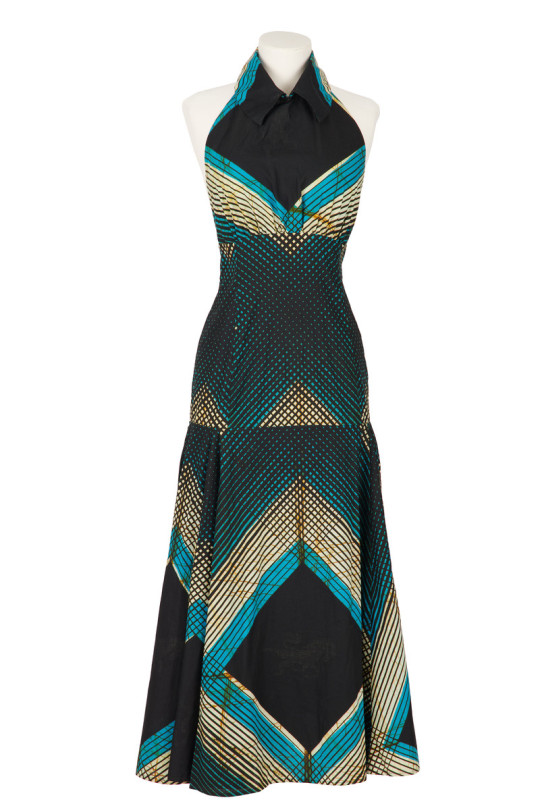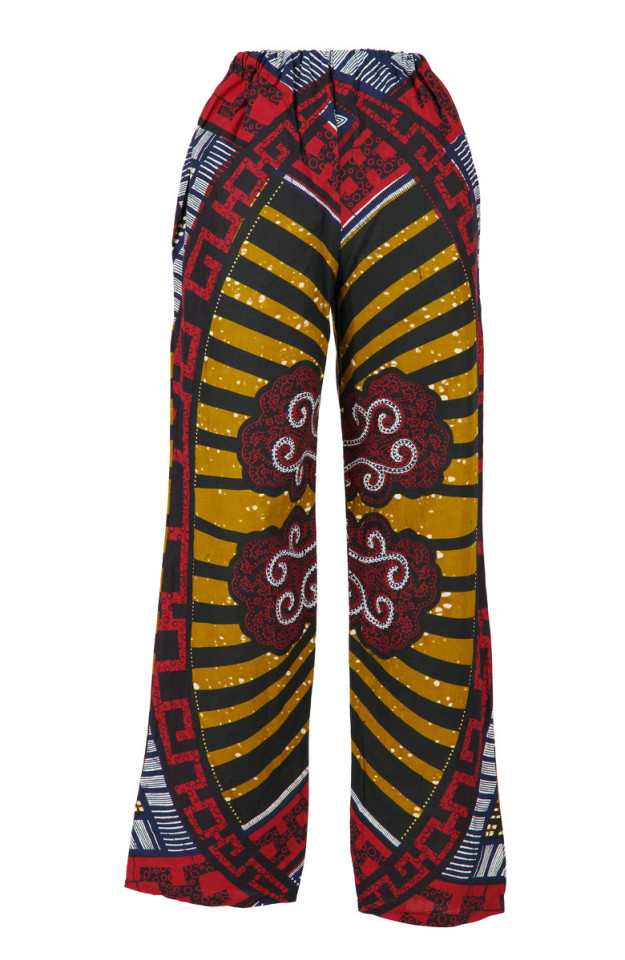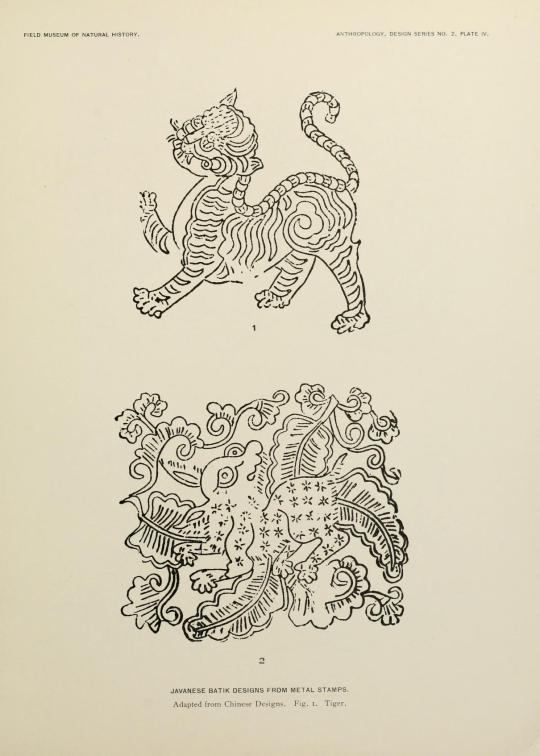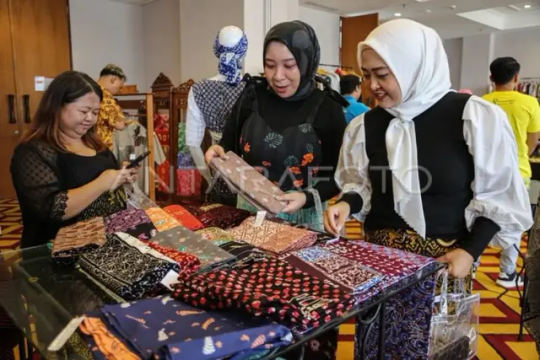#museum batik
Explore tagged Tumblr posts
Text
Tempat Wisata Menarik yang Dapat Kamu Kunjungi di Pekalongan
Halo Sobat Liburan, mau tau gak tempat wisata menarik di Pekalongan? Mungkin banyak dari sobat liburan yang langsung tau Pekalongan itu identik banget dengan batiknya. Namun ada banyak juga loh yang menarik selain oleh-oleh batiknya. Nah berikut liburanterus kasih rekomendasi tempat wisata di Pekalongan yang gak afdol kalau belum kamu kunjungi, yuk dicek! 1. Museum Batik Pekalongan Kalau ke…

View On WordPress
#batik#destinasi#dino park soko langit#dinosaurus#edukasi#jawa#liburan#liburanterus#mangrove#museum#museum batik#pekalongan#taman#Travel#wisata#wisata edukasi#wisata sejarah
0 notes
Photo






Garments made by ABC Textiles to promote batik (wax print) fabric. Company now owned by Akosombo Textiles Limited in Ghana.
c.1990
Royal Pavilion & Museums, Brighton & Hove
#fashion history#vintage fashion#1990s#non western fashion#dress#blouse#skirt#pants#shirt#batik#20th century#wax print#ghana#west africa#royal pavilion and museums#brighton and hove museums and art galleries
338 notes
·
View notes
Text






Some indoor spots of Museum Tanah dan Pertanian (Soil and Agriculture Museum or MUSTANI). Located in Bogor, Indonesia.
Location: Museum Tanah dan Pertanian
Where to find more picts: here
#landmark#street photography#cityscape#urban#urban photography#traffic#photography#city life#architecture#landscape#building#museum#soil#agriculture#stones#poultry#batik#insects#indoor#bogor#indonesia
7 notes
·
View notes
Text
Nostalgia..di Museum Batik Ullen Sentalu Yogya

0 notes
Text





The Los Angeles County Museum of Art





youtube
112 notes
·
View notes
Text
When the Manila Metropolitan Theater (abbreviated as MET) was formally opened on December 10, 1931, it was considered the country’s first national theater. In 1973, it was inscribed as a National Historic Landmark. The National Museum of the Philippines declared it a National Culture Treasure in 2010 because it’s a unique, well-preserved Art Deco building of an outstanding size in Asia.
It hasn't been always been in the limelight since its opening. Before it re-acquired its stature as the "Grand Dame of Manila," the building has suffered. The MET was damaged during the 1945 Battle of Manila and was used for various purposes in the following years—as a boxing gym, a seedy motel, a gay bar, a basketball court, a garage, and a warehouse. It was restored under the auspices of Imelda Marcos in 1978 and then shuttered again in 1996 due to conflicts of ownership between the City of Manila and the government insurance company that sponsored its restoration.
A government arm, the National Commission for Culture and the Arts (NCCA) bought the theater from the the government insurance company in 2015 and started restoration work in February 2017. After its most extensive public restoration efforts, the MET reopened on December 10, 2021—90 years after its inauguration
The building was designed by a Filipino architect Juan M. Arrelano, who had to undertake additional studies in the United States to learn theater design, as he had previously specialized in Neoclassical buildings. His earlier works include the nearby National Museum of Fine Arts, Manila Post Office, and Jones Bridge.
The MET is known for its Art Deco design, but Arrelano made sure that Filipino decorative elements were incorporated throughout the building: batik patterns of the southern Mindanaon regions, capiz lamps, and banana leaf pillars. It gets better when you look up at the ceiling of the main theater, which is embellished with mangoes, bananas, and tropical leaves.
14 notes
·
View notes
Text











Batik Fabled Cloth of Java
Inger McCabe Elliott
collabration Paramita Abdurachman, Susan Blum, Iwan Tirta, photo by Brian Clarke
Periplus Editions, Hong Kong 2004, 240 pages, 23x30,5cm, paperback, ISBN978-0-7946-0668-8
euro 40,00
email if you want to buy [email protected]
Batik: Fabled Cloth of Java is a sumptuous, classic book, richly illustrated with color plates of the finest antique and contemporary batik from thirty museums and private collections around the world. It includes historical photographs, etchings, engravings, maps and photographs of modern Java.
10/03/24
16 notes
·
View notes
Text

Albert Buell Lewis (1867-1940), Javanese Batik Designs from Metal Stamps, Chicago, Field Museum of Natural History, Anthropology of Design Series, no. 2, 1924.
Digitized for the Biodiversity Heritage Library.
12 notes
·
View notes
Text



Cloth, belongs to a series of cotton samples that show the different phases of the batik technique - 0 - National Museum of World Cultures Foundation, Netherlands - CC0.
#archive aesthetic#digital archives#museum#archivecore#art#art history#cloth#textile#pattern#inspiration#aesthetic
3 notes
·
View notes
Text

Puteri Indonesia DKI Jakarta 5 Regional Costume: The Legend of Batavia Maskerspel
This costume was inspired by the picture of Jakarta as a port city where the exchange of commodities between the nations of China, India, Arabia, Europe and the Archipelago took place. At the head there is a ship shape that indicates the city of Jakarta has the main sea line trading area from several states in the northern part of Jakarta. While the foundation part of the ship is the Kota Tua museum building as one of Jakarta's landmarks that are not far from the harbor area. For the reason the exchange became a cultural unity depicted by the Betawi mask dance. The mask dance was initially pinned because the dancer wore a mask, developing from the popular game in its history called Klain Maskerspel in Dutch which means "mask game". Living up to its name, the dancer will use a wooden mask as a face cover. The merriment that is a characteristic of Betawi culture is also shown in the colorful Betawi dress as well as depicting the diversity of people who come from various areas throughout Indonesia to live in the city of Jakarta. Dancer costume wrapped with Jakarta Batik with a touch of bamboo shoots stump motif combined with Monas building motifs, Ondel-ondel, Tanjidor musical instrument as well as coconut flowers signature of Betawi culture.
30 notes
·
View notes
Text
Galle Fort Sri Lanka – Exploring a Timeless Gem in Sri Lanka

Nestled along the sun-kissed southern coast of Sri Lanka, Galle Fort is a place where history, culture, and breathtaking scenery come together. This UNESCO World Heritage Site is more than just an ancient fortress—it’s a living, breathing testament to the island’s colonial past, offering travelers a glimpse into a bygone era. With its cobbled streets, charming cafés, boutique shops, and stunning ocean views, Galle Fort is a must-visit destination for those seeking a blend of history and coastal charm.
The Rich History of Galle Fort
Built by the Portuguese in the 16th century and later fortified by the Dutch, Galle Fort has stood the test of time for over 400 years. The fortress, with its massive stone ramparts, bastions, and colonial-era buildings, reflects a fusion of European and South Asian influences. Today, it remains one of the best-preserved forts in Asia, attracting visitors from around the world.
Top Things to Do in Galle Fort
1. Walk Along the Historic Ramparts 🏰 Enjoy a scenic stroll along the fort’s ancient walls, where you’ll be greeted by breathtaking views of the Indian Ocean. The golden hour is especially magical, making it the perfect spot for photographers and sunset lovers alike.
2. Visit the Iconic Galle Lighthouse 🌅 One of Sri Lanka’s most photographed landmarks, the Galle Lighthouse stands tall as the oldest lighthouse in the country. It’s an unmissable sight and offers a picture-perfect backdrop for your travel memories.
3. Explore the Galle National Museum 🏛️ Step inside this fascinating museum to discover artifacts, old photographs, and colonial relics that tell the story of Galle’s vibrant past.
4. Shop at Boutique Stores & Art Galleries 🛍️ Galle Fort is known for its charming boutiques, selling everything from handcrafted jewelry and vibrant batik clothing to unique souvenirs and local artwork.
5. Indulge in Sri Lankan & International Cuisine 🍛 From cozy cafés to fine dining, Galle Fort offers a variety of dining experiences. Don’t miss trying authentic Sri Lankan rice & curry, fresh seafood, and tropical fruit juices while enjoying the colonial charm of the old town.
6. Visit the Dutch Reformed Church ⛪ A beautiful piece of history, this church dates back to the 18th century and features impressive architecture, stained-glass windows, and tombstones that tell tales of the past.
Tips for Visiting Galle Fort
✔️ Best Time to Visit – The fort is beautiful year-round, but visiting during the dry season (December to April) offers the best weather for exploring. ✔️ Wear Comfortable Shoes – The cobbled streets and uneven paths make walking a bit tricky, so comfortable footwear is a must! ✔️ Stay Overnight – While a day trip is great, staying overnight lets you experience the fort’s magical ambiance after dark when the streets are quieter. ✔️ Respect the Heritage – As a living monument, Galle Fort is home to many locals—so be mindful and respectful while exploring.
Why Galle Fort Should Be on Your Bucket List
Galle Fort is not just a historic site—it’s an experience. Whether you’re wandering through its colonial streets, enjoying a seaside sunset, or immersing yourself in its culture, this timeless gem leaves a lasting impression on every traveler.
Ready to explore this historic marvel? Get all the details for your visit at World Travel Eye.
0 notes
Text
TURISIAN.com - Di lereng sejuk Gunung Merapi, terselip sebuah museum yang menyimpan jejak kejayaan Mataram. Namanya, Museum Ullen Sentalu. Ini bukan sekadar tempat wisata biasa, melainkan jendela yang membuka cakrawala budaya Jawa. Tentu saja, dengan koleksi berharga dan narasi sejarah yang mendalam. Museum ini menghadirkan peninggalan dari kerajaan Mataram, mulai dari lukisan, batik, hingga syair penuh filosofi. Lebih dari sekadar pameran, setiap sudutnya dirancang untuk menghidupkan kembali kisah-kisah masa lalu dalam sebuah pengalaman yang imersif. Tak hanya koleksi yang memikat, museum ini juga menawarkan tur eksklusif dengan konsep yang telah dikurasi secara cermat. Setiap tur mengajak pengunjung menelusuri jejak budaya Jawa dalam berbagai aspek. Ragam Tur dan Tarif Tur Adiluhung Mataram – Rp 50.000 Menyajikan koleksi lukisan, syair, dan batik yang menggambarkan kehidupan keluarga kerajaan Mataram. Rute tur meliputi Guwa Sela Giri dan Kampung Kambang. Tur Skriptorium – Rp 60.000 Menelusuri peradaban Jawa dari era Medang hingga masa kolonial. Tur ini berfokus pada manuskrip kuno dan perjalanan budaya yang terekam dalam sejarah. Tur Vorstenlanden – Rp 100.000 Mengupas akulturasi budaya Jawa dan Belanda dalam sejarah kerajaan Mataram. Tur ini mencakup kunjungan ke Esther Huis dan ditutup dengan sajian teh atau kopi. English Guided Tour – Rp 100.000 Tur berbahasa Inggris dengan edukator profesional, khusus bagi wisatawan asing yang ingin memahami budaya Jawa lebih dalam. Jam Operasional dan Reservasi Museum Ullen Sentalu buka setiap Selasa hingga Minggu, mulai pukul 08.30 hingga 16.00 WIB. Tur terakhir dimulai pukul 15.15 WIB, sehingga disarankan datang lebih awal untuk mendapatkan pengalaman terbaik. Untuk rombongan lebih dari 25 orang, reservasi diwajibkan melalui nomor (0274) 880158. Sementara pengunjung individu dapat langsung membeli tiket di loket tanpa perlu reservasi terlebih dahulu. Tips Berkunjung Agar pengalaman wisata semakin berkesan, simak beberapa tips berikut: Datang lebih pagi untuk menghindari antrean panjang di loket. Kenakan pakaian nyaman karena tur melibatkan banyak aktivitas berjalan kaki. Patuhi aturan museum, termasuk larangan mengambil foto di dalam ruang pameran. Siapkan uang tunai, karena pembayaran tiket hanya bisa dilakukan secara langsung. Perhatikan cuaca, bawa jaket ringan mengingat lokasi museum berada di dataran tinggi. Museum Ullen Sentalu adalah destinasi bagi mereka yang ingin menyelami budaya Jawa dalam atmosfer yang syahdu. Di balik setiap artefak, tersimpan kisah yang menunggu untuk dijelajahi.
0 notes
Text
Pura Mangkunegaran: Pesona Sejarah dan Budaya di Jantung Kota Solo
Selasa, 25 Februari 2025
Penulis : Azizah
Saat berkunjung ke Kota Surakarta jangan lupa untuk mampir ke Pura Mangkunegara ya.... karena banyak hal yang menarik disana. Pura Mangkunegaran berada di Jalan Ronggowarsito, Kelurahan Keprabon, Kec. Banjarmasin, Kota Surakarta, Jawa Tengah.
Pura Mangkuneran merupakan salah satu tempat bersejarah yang ada di Surakarta kalau kalian suka belajar sejarah Pura Mangkunegaran cocok banget deh... walalupun kalian ga terlalu tertarik dengan sejarah ga usah ragu untuk mampir ya soalnya kalian bisa menikmati keindahan bangunannya yang hampir keseluruhannya terbuat dari kayu serta kalian bisa mengunjungi Museumnya yang penyimpan berbagai koleksi benda bersejarah, keren bukan....

sumber : Solopos.com
Pura Mangkunegaran adalah tempat bersejarah yang didirikan oleh Raden Mas Said pada tahun 1752. Ditengah kehidupan modern saat ini Pura Mangkunegaran masih menjaga dan melestarikan budaya dan tradisi ada Jawa, jadi banyak wisatan yang tertarik dengan hal tersebut kalian harus jadi salah satu wisatawannya ya...
Saat berkunjung ke Pura Mangkunegaran kalian bisa mengunjungi berbagai tempat yang dibuka untuk umum, diataranya yaitu:
Pamedan
Pamedan adalah lapangan hijau yang digunakan sebagai tempat latihan prajurit Mangkunegaran.
2. Pendopo Ageng
Pendopo Ageng adalah pendopo yang berbentuk joglo berukuran 3.500 meter persegi yang dapat menampung 10.000 orang.
3. Pringgitan
Bangunan ini berbentuk kuthuk ngambang yang berada di belakang Pendopo Ageng. Tempat ini digunakan untuk pertunjukan wayang atau untuk menerima tamu agung.
4. Ndalem Ageng
Bangunan ini berbentuk limasanyang berfungsi sebagai Museum yang memajang berbagai benda dan berbagai hal yan terkait dengan Pura Mangkunegaran.
5. Keputren
Keputren adalah tempat tinggal keluarga kerajaan, didalamnya terdapat taman yang berhias patung-atung bergaya klasik Eropa dan terdapat air mancurnya.
6. Pracimoyasa
Pracimoyoso adalah ruangan keluarga yang menghadap taman terbuka, bagian ini digunakan untuk rapat dan acara-acara besar.
Tarif dan Jam Operasional
Untuk berkunjung ke Pura Mangkunegaran dikenakan biaya Rp. 30.000 untuk wisatawan lokal dan Rp. 50.000 untuk wisatawan internasional. Pura Mangkunegaran buka setiap hari Senin, Selasa, Rabu, Jumat, Sabtu, dan Minggu dari pukul 09.00-15.00 WIB. Setiap hari Senin Wage dan Kamis buka pukul 09.00-14.00. Tutup setiap tanggak merah dan libur nasional.
Aturan di Pura Mangkunegaran
Untuk kalian yang ingin menggunjungi Pura Mangkunegaran jangan lupa untuk mematuhi dan menerapkan hal dibawah ini yaa..
Dilarang membuang sampah sembarangan.
Menggunakan pakaian yang sopan dan menggunakan bawahan yang panjang.
Tidak diizinkan untuk memotret diarea tertentu, terutama di ruangan Dalem Ageng.
Tidak diperbolehkan menggunakan Batik motif parang atau lereng.
Dilarang merokok dan dilarang membawa senjata tajam.
Tidak dibolehkan untuk menggunakan sandal jepit atatu slippers.
Ayo tunggu apalagi? coba dan rasakan pesona dari Pura Mangkunegaran yang sangat indah!! Dijamin pengalaman kalian selama di sini akan meningkat dan semakin berkesan!!!
2 notes
·
View notes
Text

Disbud DKI gelar Pameran Batik Tuban di Museum Tekstil
Dinas Kebudayaan DKI Jakarta menyelenggarakan Pameran Batik Tuban koleksi Museum Tekstil dan Yayasan Batik Indonesia dengan tema “Bangga Berbatik: Pesona Batik Tuban” di Museum Tekstil, Jalan KS Tubun, Jakarta Barat.
Pameran yang digelar dalam rangka merayakan Hari Batik Nasional tahun 2024 itu berlangsung pada Selasa 1 Oktober hingga Minggu (6/10) pukul 09.00 sampai 15.00 WIB.
“Pameran ini menyajikan 83 helai koleksi kain Batik Tuban yang dimiliki Museum Tekstil, Yayasan Batik Indonesia dan para kolektor Batik,” kata Kepala Dinas Kebudayaan Provinsi DKI Jakarta, Iwan Henry Wardhana di Jakarta, Selasa.
Berita lengkapnya : Klik disini
0 notes
Text
Exploring the World through Cultural Travel Experiences

In an increasingly connected world, travelers are seeking more meaningful ways to experience new destinations. Cultural travel experiences have emerged as a significant trend, offering a deeper understanding of the world’s diverse cultures, traditions, and histories. This article explores the importance and impact of cultural travel, highlighting key destinations and activities that provide enriching experiences.
Understanding Cultural Travel
Cultural travel is about immersing oneself in the local culture of a destination. This type of travel goes beyond sightseeing and involves engaging with the traditions, lifestyles, and histories of the people who live there. It provides a chance to learn about different ways of life and to appreciate the world’s rich cultural diversity. By choosing cultural travel, visitors contribute to preserving cultural heritage and supporting local communities.
Key Destinations for Cultural Travel
1. Kyoto, Japan
Kyoto, the cultural heart of Japan, offers an array of experiences that highlight the country’s traditional arts and customs. Visitors can participate in a tea ceremony, explore ancient temples, and attend traditional festivals like Gion Matsuri. The city’s well-preserved architecture and gardens provide a glimpse into Japan’s imperial past.
2. Cusco, Peru
As the gateway to Machu Picchu, Cusco is steeped in Incan history and Spanish colonial influence. Travelers can explore the ruins of Sacsayhuamán, visit the vibrant San Pedro market, and learn about Andean traditions and crafts. The annual Inti Raymi festival, celebrating the Incan sun god, offers a unique cultural experience.
3. Marrakech, Morocco
Marrakech is a sensory feast of colors, sounds, and scents. The city’s medina is a UNESCO World Heritage site, where travelers can wander through bustling souks, admire intricate Moorish architecture, and savor Moroccan cuisine. Cultural tours often include visits to traditional riads and workshops with local artisans.
4. Varanasi, India
One of the oldest inhabited cities in the world, Varanasi is a spiritual hub for Hindus. Travelers can witness the mesmerizing Ganga Aarti ceremony on the banks of the Ganges River and explore the city’s labyrinthine streets. Varanasi offers a profound cultural experience that delves into India’s diverse religious practices.
5. New Orleans, Louisiana
Known for its vibrant music scene, especially jazz, and its unique Creole and Cajun cultures. Visitors can explore the French Quarter, enjoy Mardi Gras festivities, and taste authentic Southern cuisine.
6. Santa Fe, New Mexico
Celebrated for its Pueblo-style architecture and as a hub for Native American culture and art. The city hosts numerous art galleries, museums, and the annual Santa Fe Indian Market.
7. Charleston, South Carolina
Offers a deep dive into American history with its well-preserved colonial architecture and plantations. The city's cultural scene includes traditional Gullah music and cuisine.
8. San Francisco, California
Known for its multicultural neighborhoods like Chinatown and the Mission District. The city offers cultural festivals, diverse culinary experiences, and iconic landmarks like Alcatraz and the Golden Gate Bridge.
9. Chicago, Illinois
Renowned for its architectural tours, vibrant arts scene, and diverse cultural neighborhoods. Highlights include the Art Institute of Chicago, jazz and blues clubs, and ethnic festivals celebrating the city's heritage.
Activities to Enhance Cultural Travel
Participate in Local Workshops
Engaging in local workshops is an excellent way to learn about a destination’s crafts and traditions. Whether it’s pottery making in Mexico or Batik painting in Indonesia, these hands-on experiences provide insight into the local culture and support traditional artisans.
Attend Cultural Festivals
Festivals are vibrant expressions of a community’s culture and offer travelers a unique perspective on local traditions. Events like Holi in India, the Carnival in Brazil, and the Lantern Festival in Taiwan showcase music, dance, and rituals that are intrinsic to the community’s identity.
Stay with Local Families
Homestays provide an opportunity to live with local families and experience daily life in the community. This form of accommodation fosters cultural exchange and allows travelers to form personal connections, gaining a deeper understanding of the local way of life.
Explore Historical Sites
Visiting historical sites aids in understanding the historical context of a culture. Sites like the Great Wall of China, the Colosseum in Italy, and the pyramids of Egypt reveal the architectural feats and historical narratives of ancient civilizations.
Benefits of Cultural Travel
Cultural travel offers numerous benefits both to travelers and host communities. For travelers, it leads to personal growth, broadening perspectives and fostering empathy and understanding. For host communities, it provides economic support and helps preserve cultural heritage. Additionally, it encourages sustainable tourism practices that respect the environment and local customs.
Tips for Responsible Cultural Travel
To ensure that cultural travel is respectful and beneficial, consider the following tips:
Research: Understand the customs and traditions of the destination before visiting.
Respect: Be mindful of local customs, dress codes, and religious practices.
Support Local: Choose local guides, eat at locally-owned restaurants, and purchase handmade crafts.
Learn the Language: Even basic knowledge of the local language can enhance interactions and show respect.
Leave No Trace: Follow sustainable practices to preserve the environment and cultural sites.
Conclusion
Cultural travel experiences open the door to the world’s rich tapestry of traditions and histories. By engaging with local communities, participating in cultural activities, and respecting diverse customs, travelers can gain a more meaningful and fulfilling travel experience. Cultural travel not only enriches the traveler but also helps sustain and celebrate the diversity that makes our world unique.
0 notes









